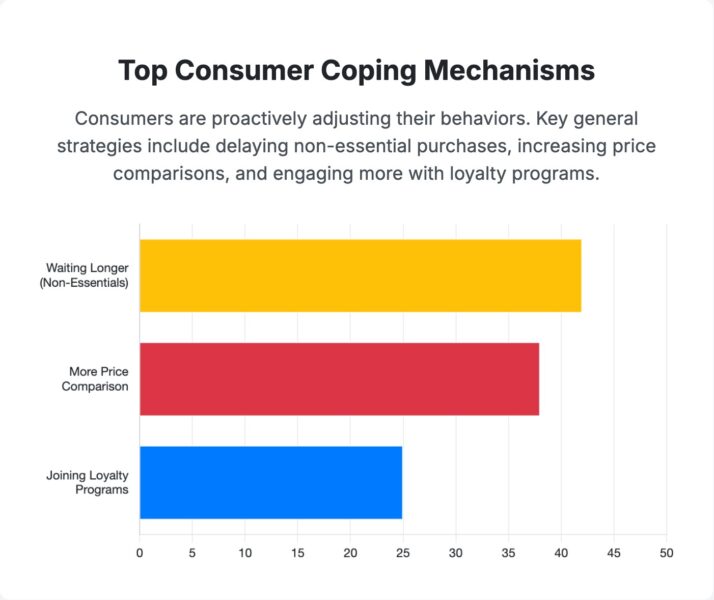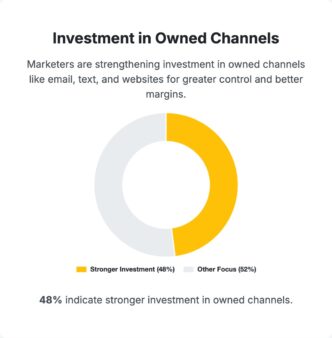
Consumer confidence has been increasingly volatile since the presidential election. The new administration’s higher tariffs, lower government spending and radical tax changes have unnerved many people. The University of Michigan’s Consumer Sentiment Index has fallen from 74 in December to 50.8 in April. After five months of declines, The Conference Board Consumer Confidence Survey surged in May, but remains below where it was in 2021.
Here’s what consumers and marketers are already doing to cope with the economic uncertainty.
Consumers
Price, not brand, is driving decisions: 76% of U.S. consumers are either “very likely” (36%) or “somewhat likely” (40%) to change brands for a better price or value, according to a survey by performance marketing firm Wunderkind. That’s even more pronounced among younger consumers, with 42% of Millennials and 37% of Gen Z in the “very likely” category.
“The constant and unpredictable reversals and adjustments of tariffs lack consistent context, meaning consumers don’t know how to properly plan for their immediate budgetary future, much less a long-term one,” said Greg Zakowicz, senior ecommerce expert at marketing automation company Omnisend.

There is no loyalty: Nearly 90% of consumers will change brands if they see a significant price hike, according to Wunderkind’s 2025 May Marketers/Consumer Tariffs Impact report. What’s significant? Two-thirds will jump to a new brand for a 20% or less price difference, with most saying the tipping point is 11%-20%. FYI: While new tariffs vary by nation, the current average of all tariff increases is 17.8%, according to the Yale Budget Lab. That was calculated before President Trump threatened the EU with a 50% tariff last week.
Dig deeper: In a world of tariffs and turmoil, marketing’s insight is a superpower
Significant buying changes underway: Consumers are showing more discipline in discretionary spending.
- 42% are waiting longer before buying non-essential items.
- In the grocery and essentials category, 40% are switching to less expensive or store/private-label brands, and 33% are stockpiling when prices are lower.
- For apparel, 43% are waiting for sales or promotions. Switching to less expensive brands (33%) and shopping thrift or second-hand (29%) are also gaining traction.
- 47% are delaying the purchase of high-ticket items (over $200) until necessary, 44% are waiting for sales or promotions and 30% are switching to less expensive brands.
Here for the long term: 36% of consumers expect to feel the economic squeeze “through the end of 2025 or longer.” That’s more than double any other answer. Older shoppers are the most pessimistic, with 49% of Boomers expecting to be affected for at least the rest of the year. Only 17% believe tariffs won’t significantly disrupt their shopping behavior. For marketers, this underscores the need for strategies built for endurance.
Businesses are as pessimistic as consumers. A survey of SMB merchants by Omnisend found:
- 36.8% anticipate a negative business impact from tariffs.
- 13.2% expect it to be “significant.”
- 64% expect consumers will spend less over the next 12 months.
Marketers
Marketers are adjusting prices and prioritizing owned channels and data.
Don’t say “tariff”: Companies dislike raising prices for reasons beyond their control. If they do, the best practice in marketing is to be transparent and honest about why it is happening. However, using the word tariff can draw the wrath of President Trump, as seen with Amazon, Walmart, Mattel and others.
The Conference Board even issued an advisory about using the “T” word.
“Avoid breaking out tariff-induced costs, which could be interpreted by some as a political statement, to maintain neutrality. Instead, explain that input, import, or sourcing costs have risen without mentioning the term ‘tariffs’ directly, which might be too politically charged.”
It’s worth noting that 81% of U.S. consumers report high awareness of news about tariffs, according to the Wunderkind survey. So, they know why prices are rising, even if you don’t tell them.
Dig deeper: Winning customer loyalty starts with straight talk about tariffs
Prices are indeed going up: 57% of marketers say they are selectively increasing prices in tariff-impacted categories, and 72% of brands are increasing prices due to the tariffs, according to Wunderkind.

Turning to owned channels: Aside from pricing, marketers are making some big strategic changes. The most common move, 48% of respondents say, is focusing more on owned channels like email, text and websites. That points to a clear shift toward options that offer more control, stronger margins, and a direct line to the customer.
“Brands may need to re-evaluate their pricing strategies to account for additional headwinds, such as tariff costs, and really understand their shifting customer behaviors,” said Cary Lawrence, CEO of consumer analytics company Decile. “Doubling down on personalization to mitigate price or discount sensitivities is no longer optional — it’s a requirement.”
That explains why 48% of marketers said first-party data growth is their top opportunity for 2025. That indicates a foundational shift towards leveraging owned data for personalization, segmentation, and retention.
Additionally, performance-based marketing solutions are the top priority for martech investment (56%), showing a demand for technologies that deliver guaranteed, measurable outcomes. Marketers are also testing new product pricing and value bundles (45%) and increasing promotional offers and discounts (40%) as part of their response.
Dig deeper: 3 ways to turn tariff turmoil into marketing gold
Sad holidays ahead? While consumers consider the immediate price impact, marketers are planning for the impact on holiday shopping. More than two-thirds (68%) say they are modifying holiday strategies. They are shifting from reactive to proactive planning, testing messaging and offers earlier in the year to refine execution ahead of peak holiday demand.
Retailers will likely see the most acute effects as production costs increase dramatically for overseas production. In addition to raising prices, retailers will cut spending to retain margins, and as you know, marketing is a favorite place to cut. Social, search and retail media as the channels most likely to see a drop in ad spend, according to a report by Advertiser Perceptions. That is because they over-index on performance advertisers and brands, particularly those based in China.
“Historically, brand advertising has struggled in tough economic times, while performance has been more resilient,” the report said. “This will be the case this time, but the brands with the largest performance budgets (retailers) will be impacted most severely overall.”
On the other hand, companies that invest more in upper-funnel ads might be better positioned to weather the impact.
Going into 2025, marketers expected their budgets to stay the same, and advertisers saw solid growth for media budgets. Now, as tariffs are raised, then lowered, then raised not-quite-as-high, no one can say what’s next. What we do know is that far fewer cargo ships are arriving in U.S. ports and consumers are pulling in their wings. Those are likely the best economic indicators to plan around.
The post How tariffs are reshaping long-term strategies for brands and buyers appeared first on MarTech.
